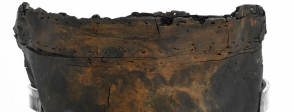The first two activities encourage the students to look at the object carefully, collect information about it and start to develop opinions.
Ask the students to describe the object: colour(s), shape, decorative pictures, writing, materials it is made from, whether damaged or complete. Ask them to think about the function of the object: what was it used for, who may have used it, do we use anything like the object today? Use the two other 17th century fire buckets in A bigger picture and compare them with this one.
Ask the students to create a label for the bucket. They should start the label with information about the bucket (facts) and follow this with their thoughts about who might have used it and how it came to be left in the cellar (opinions). Discuss the differences with them.
Explore the 17th century print of firefighting in A bigger picture. Look at the other resources in A bigger picture and ask the students to connect them with the 17th century print. They should be able to find hooks, buckets and houses close to each other.
The bucket was probably dropped by somebody fleeing the fire. After you have studied the course of the fire and looked at Pepys’ and Evelyn’s diaries, ask the students to imagine that they were the person who had been using the bucket during the Great Fire of London. Ask them to write a first-person account of what they were doing and how the bucket was lost or to stage interviews with each other.
Was the Great Fire of London a good thing? Find out about the changes that took place in London after the fire. Set up a class discussion about whether the Great Fire of London was a good or bad event in the history of the city. You may need to encourage students to think of bad outcomes such as the loss of life, financial ruin for individuals and loss of people’s homes and possessions.
Compare the two plans for rebuilding the city in For the classroom. Which do the students think would have been the better?
The Great Fire is probably the inspiration for the traditional round London’s Burning. Investigate further examples of traditional songs or rhythm about local events or places, for example the London songs Oranges and Lemons and London Bridge is Falling Down. Learn and perform some of these songs.
Investigate how effective it is to pass a bucket of water along a line of people. Fill a small bucket and pass it along a line of people and measure how much water arrives at the other end. What is the effect of varying factors such as the size of the bucket, the initial amount of water, the number of people in the line, the speed at which the bucket is passed?
Make a bucket from different materials – set up a scientific investigation to determine how effective different materials are for making a bucket. Shape small containers from a range of materials and pour a set amount of water into each contain and observe what happens. Students can record whether the material is waterproof and other factors such as weight and durability to determine the best material for the job.
Here are some broader enquiries.
Why did the Fire of London spread so fast? Gather together some factors related to the spread of the fire, using the bucket and the other resources in A bigger picture. Do some class research then rank the factors in order of importance and create a synthesis of findings explaining the reasons for the choices.
How did firefighting improve after 1666? Find out more about firefighting in the 17th century and improvements such as the fire engine developed by John Keeling of Blackfriars in the 1670s. Work through to the present finding out about modern firefighting techniques and comparing these with those used in Stuart times.
Investigate other historical fires such as the Fire of Northampton (1675), the Great Fire of Warwick (1694), the Great Fire of Newcastle and Gateshead (1854) and the fire at Cowgate, Edinburgh (2002).


